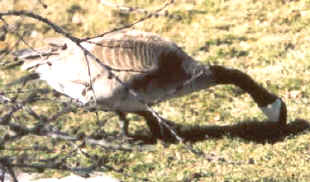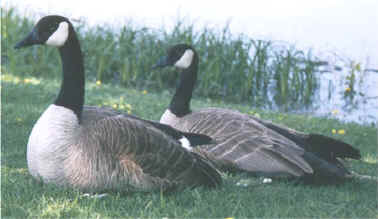One of my favorite spring and autumn memories ever since my early childhood was hearing the honk of the Canada Geese. I'd peer up at the sky and look for the telltale V-formation of the flock of geese returning to Canada for the summer or leaving for the winter. This spring, I couldn't help but smile when I noticed my daughters straining their necks in search of the geese.
Distribution/Location


General: Canada Geese are waterfowl that live throughout most of North America. They are famous for their life-long mating, though a widowed goose will usually choose another mate.
The gray area in the picture to the left represents the Canada Goose's breeding area. As you can see, it's extremely widespread.
Tracks: The webbed feet of the Canada Goose are apparent when looking at their tracks.

Feeding:
Canada Geese, like most waterfowl, eat aquatic vegetation, grass, roots and young sprouts. They also eat grain and corn from agricultural areas.
Canada Geese, like most waterfowl, eat aquatic vegetation, grass, roots and young sprouts. They also eat grain and corn from agricultural areas.


Habitat:
Canada Geese live around ponds, river and lake shores. They've become quite a common sight in city parks -- some cities are having trouble with overpopulation of the geese and, for this reason, are trying to discourage people from feeding them in the overpopulated areas.
Canada Geese live around ponds, river and lake shores. They've become quite a common sight in city parks -- some cities are having trouble with overpopulation of the geese and, for this reason, are trying to discourage people from feeding them in the overpopulated areas.

Nesting:
Canada Geese build their nest with grass and plant material and line it with feather down. The geese typically nest on the ground on islands and shorelines. However, they're very adaptable birds and in urban settings nest where ever it seems safe to them -- even on the edge of the runway at the airport or on the edge of the water traps on the golf course!
Canada Geese build their nest with grass and plant material and line it with feather down. The geese typically nest on the ground on islands and shorelines. However, they're very adaptable birds and in urban settings nest where ever it seems safe to them -- even on the edge of the runway at the airport or on the edge of the water traps on the golf course!

The female lays her eggs as soon as there is open water for mating and snow-free nest sites.
The female typically lays a clutch of 5 to 7 white eggs (though the number can range anywhere from 2 to 12) while the male guards the nesting area. Laying the eggs is not a simple task. Each egg takes a little over a day to lay.
I can tell you from personal experience that if you accidentally wander into a nesting male's territory while looking for a good spot to lie your picnic blanket down, he'll come after you hissing with wings spread -- they look a lot bigger and move a fair bit faster when they're upset about something *grin*.
The eggs typically take about a month to incubate. The process is faster the farther north the geese nest since the summers are shorter.
The baby geese peck at their shells with the 'egg tooth' found at the end of their bill. It takes 1 to 2 days for them to free themselves from the egg.
The newly hatched babies (called 'goslings') are able to swim immediately. The male and female goose both accompany the babies during their swims.
Goslings can dive and swim for 30-40 feet underwater and they eat almost continuously to attain growth for the first migration flight.

Arctic Fox
The main enemy of the Canada Goose is people. In an attempt to control rising populations some areas have begun egg collection and/or hunting efforts to decrease the number of geese in their area.
Natural enemies include the Arctic fox, gulls, Bald Eagles, Peregrine Falcons, Snowy Owls, and Prairie Falcons.
Migration:
After the babies (called 'goslings') have hatched, the family moves away from the nesting site on foot toward more favorable feeding areas. Five weeks after the goslings hatch, the females begin moulting (the males begin right after mating). During this time, the adults are unable to fly. The adults regrow their flight feathers and are ready to fly at about the same time as the goslings are able to learn - at nine weeks old.
After the babies (called 'goslings') have hatched, the family moves away from the nesting site on foot toward more favorable feeding areas. Five weeks after the goslings hatch, the females begin moulting (the males begin right after mating). During this time, the adults are unable to fly. The adults regrow their flight feathers and are ready to fly at about the same time as the goslings are able to learn - at nine weeks old.
In autumn, as soon as the young are strong enough for the trip, they begin their migration south. They learn the migration routes from their parents and follow the same route in subsequent years.
Although an increasing number of Canada Geese are choosing to winter in Canada, especially in urban areas, the majority fly south to the United States and even Mexico.
No comments:
Post a Comment